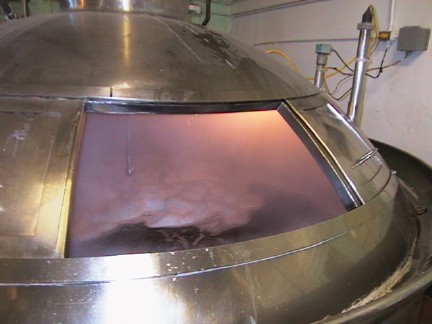A connecting pipe controlled by a valve leads from the grant to the brew kettle. The brewing technician, or "kettleman" inspects the wort during the run off period for clarity at the grant; thus ensuring that only brilliant worts are run into the kettle. He controls the rate of flow to the kettle by constant adjustment of a valve which controls the run off pipe leading from the lauter tun to the grant.
During the filtering or run off period, we sparge, or spray hot water gently over the surface of the grains to wash out any of the wort solution which may be retained in the malt husks. You will remember that this sparge water is the second half of the brewing water divided earlier.

As the last half of the wort enters the kettle, we bring the kettle to the boiling point. The kettle is a stainless steel, steam jacketed vessel fitted with a large vapour pipe or stack. It is fitted with a small, motor driven propeller to ensure ample circulation during the boiling.
Boiling accomplishes several functions. During the boil, 8 to 10% of the water evaporates off through the stack; therefore concentrating the wort. In addition, any enzyme activity which may have carried over from the lauter tun is destroyed and the wort is sterilised. Undesirable proteins are denatured, coagulated and precipitated.
Coagulation and precipitation of proteins is influenced by many factors. Malt composition, pH and subsequent wort composition will all affect the precipitation of protein. It is necessary that the proteins be at or near their isoelectric points. Therefore, coagulation is influenced by pH. The isoelectric point is the pH at which maximum precipitation occurs. The limits of pH for coagulation are 3.7 to 7.0, while 4.8 seems most favourable. A vigorous boil is necessary for maximum precipitation.
